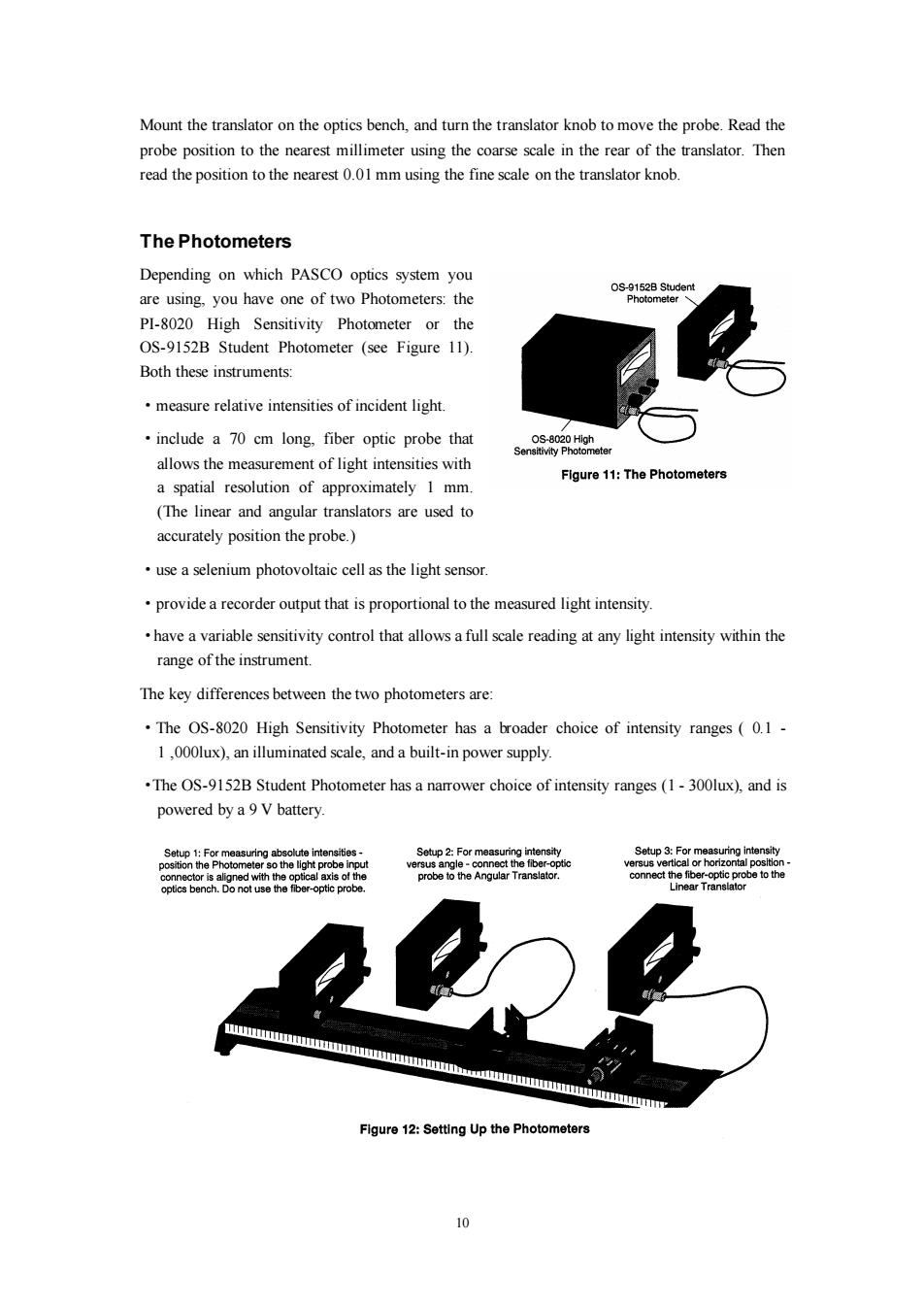正在加载图片...

Mount the translator on the optics bench,and turn the translator knob to move the probe.Read the probe position to the nearest millimeter using the coarse scale in the rear of the translator.Then read the position to the nearest 0.01 mm using the fine scale on the translator knob. The Photometers Depending on which PASCO optics system you OS-9152B Student are using,you have one of two Photometers:the Photometer PI-8020 High Sensitivity Photometer or the OS-9152B Student Photometer (see Figure 11). Both these instruments: measure relative intensities of incident light. include a 70 cm long,fiber optic probe that OS-8020 High Sensitivity Photometer allows the measurement of light intensities with Flgure 11:The Photometers a spatial resolution of approximately 1 mm. (The linear and angular translators are used to accurately position the probe.) use a selenium photovoltaic cell as the light sensor. provide a recorder output that is proportional to the measured light intensity. have a variable sensitivity control that allows a full scale reading at any light intensity within the range of the instrument. The key differences between the two photometers are: The OS-8020 High Sensitivity Photometer has a broader choice of intensity ranges(0.1 1,000lux),an illuminated scale,and a built-in power supply. .The OS-9152B Student Photometer has a narrower choice of intensity ranges(1-300lux),and is powered by a 9 V battery. Setup 1:For measuring absolute intensities- Setup 2:For measuring intensity Setup 3:For measuring intensity position the Photometer so the light probe versus angle nect the fiber-optic versus vertical or horizontal position- connector is aligned with the optical axis of the probe to the Angular Translator connect the fiber-optic probe tohe optics bench.Do not use the fiber-optic probe. Linear Translator mmmmmmmmmmmmmmommmmmmmmmm Figure 12:Setting Up the Photometers 010 Mount the translator on the optics bench, and turn the translator knob to move the probe. Read the probe position to the nearest millimeter using the coarse scale in the rear of the translator. Then read the position to the nearest 0.01 mm using the fine scale on the translator knob. The Photometers Depending on which PASCO optics system you are using, you have one of two Photometers: the PI-8020 High Sensitivity Photometer or the OS-9152B Student Photometer (see Figure 11). Both these instruments: ·measure relative intensities of incident light. ·include a 70 cm long, fiber optic probe that allows the measurement of light intensities with a spatial resolution of approximately 1 mm. (The linear and angular translators are used to accurately position the probe.) ·use a selenium photovoltaic cell as the light sensor. ·provide a recorder output that is proportional to the measured light intensity. ·have a variable sensitivity control that allows a full scale reading at any light intensity within the range of the instrument. The key differences between the two photometers are: ·The OS-8020 High Sensitivity Photometer has a broader choice of intensity ranges ( 0.1 - 1 ,000lux), an illuminated scale, and a built-in power supply. ·The OS-9152B Student Photometer has a narrower choice of intensity ranges (1 - 300lux), and is powered by a 9 V battery